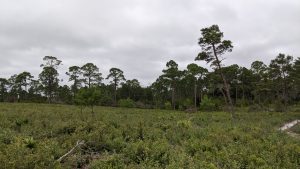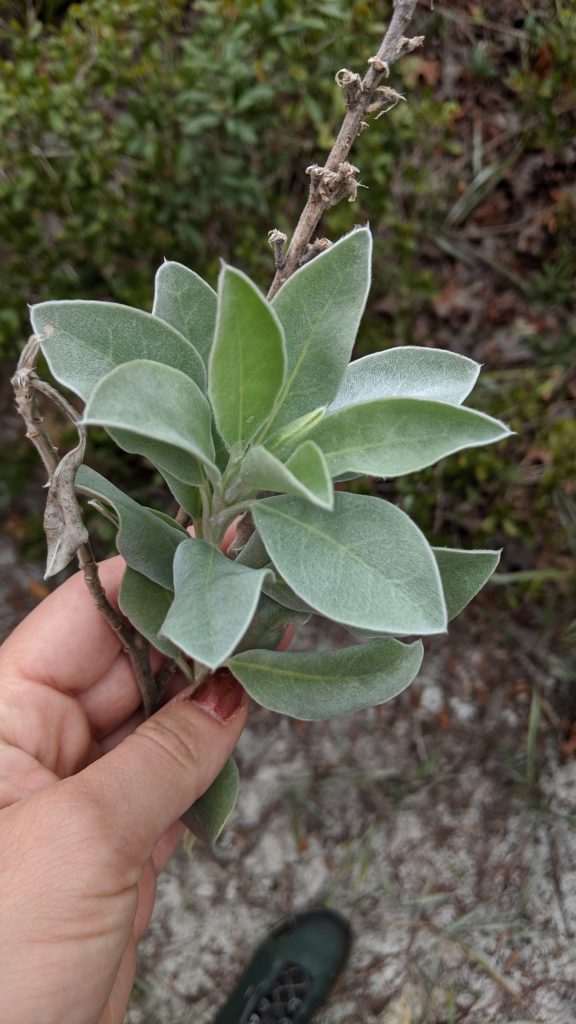
I am standing on thousand-year-old dunes. They are the ancient remnants of mountains formed of salty, wind-swept sand. Today, these dunes are now scrub and flatwood communities, home to tall sand pines, short scrubby oaks, and a plethora of biodiverse grasses and flowers.
Tate’s Hell State Forest is a conservation success that protects important ecosystems for water storage, climate change, and biodiversity (and is featured in our Gems Report). This 200,000-acre Florida Forever project provides inland-to-coastal refuge. It’s diverse ecosystems range from dwarf cypress swamps to salty, sandy scrub. Its plants and wildlife are adapted for its low-nutrient soil and seasonal wet periods. Black bear and gopher tortoise rely on this forest’s wide range of habitat.
Today the Florida Master Naturalist Program explored Tate’s Hell’s upland scrub. We were joined by Leon County UF/IFAS Extension horticulturist, Mark Tancig. A lot of my fellow classmates are Master Gardeners so the plant nerds among us (me!) had a field day. From soft-leafed lupine to fragrant scrub mint, the trail winded through sand pine scrub and oak scrub communities, teeming with plantlife. These ecosystems need to be maintained by fire, both to control overgrowth and spark new growth. Fire opens up upland pinecones and the seeds are able to sprout in the open ground, increased sun, and fertile soil. The scrub was recently roll-chopped, a mechanical land management tool that mimics fire.

Modern-day Florida was shaped by rising and receding seas, causing plants and wildlife species to be isolated and adapt to thrive in the coastal scrub’s hot, salty conditions. Forty percent of Florida scrub plants are endemic – they are native or restricted to a certain area. Examples include scrub jay and scrub rosemary. Other native (but not endemic) species of the scrub include peregrine falcon and pygmy rattlesnake – two animals I saw on the trail! Binoculars in hand, it was fun to identify the far away-raptor with my classmates. While peacefully lying under the saw palmettos off-trail, we accidentally disturbed the tiny pygmy rattlesnake. We saw several piles of palmetto seed-laden Black bear scat. Reminder: always stay on marked trails and do not approach wildlife.
Coastal scrubs are transitional zones between beach/dunes and maritime forests. They are adapted to handle the stress of salt spray, wind, and storm surge. Plants found here include prickly pear, a favorite food of gopher tortoises. We have lost much of Florida’s coastal scrub to development, a major threat to Florida species like burrowing owls and beach mice. It’s no coincidence that much of the wildlife found here are found in inland scrubs too – like the Lake Wales Ridge. The plant and wildlife on these ancient dunes have stood the test of time, proving resilient in the face of extreme conditions.
Looking at the beautiful flowers, stunted oaks, and cypress domes, I hope this place will continue to stand strong against a climate that grows wetter, hotter, and more unstable every day.
From coast to forest, land provides an important buffer between inland communities and the impacts of climate change. As seas rise, wildlife can use these drier communities to survive. During intensified hurricanes, coastal and scrub communities can hold want and slow winds.
As we look towards the future, we must continuously conserve the coastal scrub that remains, both for wildlife and for human life.





